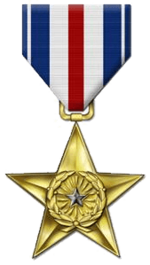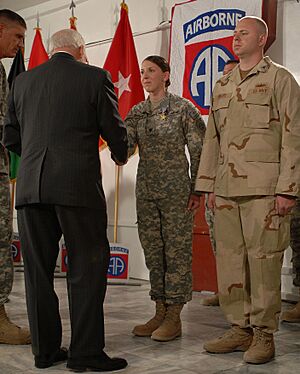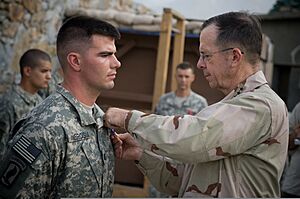Silver Star facts for kids
Quick facts for kids Silver Star Medal |
|
|---|---|
 |
|
| Type | Personal Valor Decoration |
| Eligibility | United States Armed Forces personnel, foreign allied personnel and civilians serving alongside U.S. military personnel in combat |
| Awarded for | Gallantry in action against an enemy of the United States |
| Status | Currently awarded |
| Statistics | |
| Established |
|
| Precedence | |
| Next (higher) | Army: Distinguished Service Medal (Army) Naval Service: Navy Distinguished Service Medal Air and Space Forces: Distinguished Service Medal (Air and Space Forces) Coast Guard: Coast Guard Distinguished Service Medal |
| Next (lower) | Defense Superior Service Medal |
Service ribbon |
|
The Silver Star Medal (often called SSM) is a very important military award in the United States Armed Forces. It is the third-highest award given for bravery in battle. This medal is mainly given to members of the U.S. military who show great courage when fighting an enemy of the United States.
Contents
History of the Silver Star Medal
The Silver Star Medal came from an older award called the Citation Star. This older award was created by a law on July 9, 1918, during World War I. On July 19, 1932, the Secretary of War decided to change the Citation Star into the Silver Star Medal. The original Citation Star design was even placed in the middle of the new medal.
Laws were passed to officially create the Silver Star Medal for the U.S. Navy on August 7, 1942, and for the U.S. Army on December 15, 1942. Today, the rules for giving out this medal are found in specific parts of U.S. law.
The U.S. Army calls the medal the "Silver Star." However, the Navy, Marine Corps, Air Force, Space Force, and Coast Guard call it the "Silver Star Medal." Since December 21, 2016, the Department of Defense (DoD) officially refers to it as the "Silver Star Medal."
What It Takes to Earn the Silver Star
The Silver Star Medal is given for showing great bravery, also known as gallantry. This bravery must happen during a fight against an enemy of the United States. It can also be awarded during military operations where U.S. forces are in conflict with another country. Sometimes, it's given when U.S. forces are helping friendly foreign forces fight an armed group, even if the U.S. is not directly involved in that specific war.
The brave act must be a single, outstanding moment of courage. It usually happens over a short time, like during one or two days of a battle.
Pilots in the Air Force and Navy/Marine Corps who become "aces" (meaning they have shot down five or more enemy aircraft) are often considered for the Silver Star. This is because becoming an ace means they have risked their lives many times in combat and won. For example, during the Vietnam War, some pilots who became aces received the Silver Star. Some even received higher awards for their amazing bravery.
Team Awards for Bravery
Sometimes, entire military units can be recognized for their bravery. Here are some awards that are similar to the Silver Star but given to groups:
- Air Force – Gallant Unit Citation
- Army – Valorous Unit Award
- Coast Guard – Coast Guard Unit Commendation
- Navy-Marine Corps – Navy Unit Commendation
How the Medal Looks
The Silver Star Medal is a gold five-pointed star. It is about 1.5 inches (38 mm) wide. It has a laurel wreath (a circle of leaves) around rays coming from its center. A smaller silver star, about 3/16 inches (4.8 mm) wide, is placed right in the middle. The medal hangs from a rectangular metal loop. On the back of the medal, it says FOR GALLANTRY IN ACTION.
The ribbon for the medal is about 1.375 inches (35 mm) wide. It has several stripes: a red stripe in the center, with white stripes on either side of it. Then come ultramarine blue stripes, followed by very thin white stripes, and finally, more ultramarine blue stripes on the very edges.
What the Ribbon Devices Mean
If someone receives the Silver Star Medal more than once, special devices are added to the ribbon. In the Army and Air Force, small bronze or silver oak leaf clusters are used. In the Navy, Marine Corps, and Coast Guard, small gold or silver stars (about 5/16 inch wide) are added to show multiple awards.
People Who Have Received the Silver Star

The Department of Defense does not keep exact records for every Silver Star Medal ever given. However, experts believe that between 100,000 and 150,000 Silver Stars have been awarded since the medal was created.
Some people have received the Silver Star many times. For example, Colonel David Hackworth received ten Silver Stars while serving in the Army during the Korean War and Vietnam War. General of the Army Douglas MacArthur received seven Silver Stars for his service in France during World War I.
A civilian named Donald H. Russell, who was a technical engineer, received the Silver Star for his brave actions on a U.S. Navy aircraft carrier in March 1945. Also, a Soviet Red Army officer named Alexei Voloshin received the award in 1944, making him one of the few foreign soldiers to get the Silver Star.
Female Recipients of the Silver Star
Throughout history, several brave women have also received the Silver Star.
- In 1919 and 1920, three Army nurses from World War I were recognized for their bravery. They cared for wounded soldiers while under heavy artillery fire in July 1918. It was later discovered that they had never officially received their Citation Stars. So, in 2007, these three nurses were given the Silver Star Medal after they had passed away. They were:
- Jane Rignel
- Linnie Leckrone
- Irene Robar
- During World War II, an unknown number of servicewomen received the award. Four Army nurses serving in Italy were among the first women to receive the Silver Star. They were recognized for their courage in helping to evacuate a hospital during a battle in February 1944. These nurses were:
- First Lieutenant Mary Roberts
- Second Lieutenant Elaine Roe
- Second Lieutenant Rita Virginia Rourke
- Second Lieutenant Ellen Ainsworth (awarded after her death)
- Later in 1944, Corporal Maggie Leones, a Filipino woman, received the medal for her secret activities in the Philippines.
- More recently, Army National Guard Sergeant Leigh Ann Hester received the Silver Star in 2005 for her bravery during an ambush in Iraq. Army Specialist Monica Lin Brown received it in March 2008 for her amazing heroism as a combat medic in the War in Afghanistan.
- On November 12, 2024, Captain Lacie “Sonic” Hester of the 494th Fighter Squadron was awarded the Silver Star. She was recognized for her important role in shooting down more than 80 Iranian drones that were launched at Israeli cities. She became the first female airman and the tenth female U.S. military member to receive the Silver Star.
Some Other Notable Recipients
- Lloyd Austin
- Vernon Baker
- Omar Bradley
- Monica Lin Brown
- Wesley Clark
- James H. Doolittle
- Douglas Fairbanks Jr.
- Alexander Haig
- David Hackworth (ten awards)
- Lacie Hester
- Leigh Ann Hester
- Lyndon B. Johnson
- John Kerry
- Jonny Kim
- Douglas MacArthur (seven awards)
- John McCain
- Audie Murphy (two awards)
- George S. Patton
- Chesty Puller
- H. Norman Schwarzkopf
- James Stockdale (four awards)
- Pat Tillman
- Chuck Yeager (two awards)
See also
 In Spanish: Estrella de Plata para niños
In Spanish: Estrella de Plata para niños
- List of Australian Silver Star recipients


